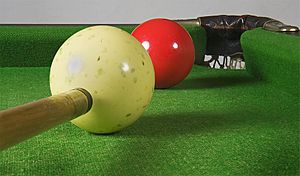Collision facts for kids
A collision happens when two objects bump into each other. Think about playing pool, bouncing a ball, or even a car crash. In every collision, a special quantity called momentum stays the same before and after the objects hit. This means the total "oomph" of the objects doesn't change.
Collisions can be split into two main types: elastic collisions and inelastic collisions. Each type behaves a bit differently, especially when it comes to energy.
Contents
What is an Elastic Collision?
Imagine bouncing a rubber ball or playing a game of pool. These are great examples of an elastic collision. In this type of collision, objects hit each other and then bounce apart.
The key thing about elastic collisions is that both the kinetic energy (the energy of movement) and the momentum are conserved. This means the total amount of kinetic energy and momentum is the same before and after the collision. Objects that are hard and bouncy, like billiard balls, usually have elastic collisions.
Even in real life, a tiny bit of energy might be lost as heat or sound. But for most purposes, we consider these collisions to be perfectly elastic.
What is an Inelastic Collision?
Now, think about a car crash or dropping a ball of clay onto the floor. These are examples of an inelastic collision. In this type of collision, objects hit each other and often stick together, or they don't bounce much.
The main difference here is that kinetic energy is not conserved. Some of the kinetic energy changes into other forms of energy, like heat, sound, or even deforming the objects (like when a car crumples). However, just like in elastic collisions, the total momentum still stays the same before and after the crash.
Collisions in Two Dimensions
Sometimes, objects don't just hit head-on in a straight line. They might hit at an angle, moving in two different directions. This is called a two-dimensional collision.
Even in these more complex situations, the basic rules for elastic and inelastic collisions still apply. We still look at how momentum and kinetic energy change. To figure out the movement of objects after hitting at an angle, scientists use vectors. Vectors help describe both the speed and direction of an object's movement.
Images for kids



